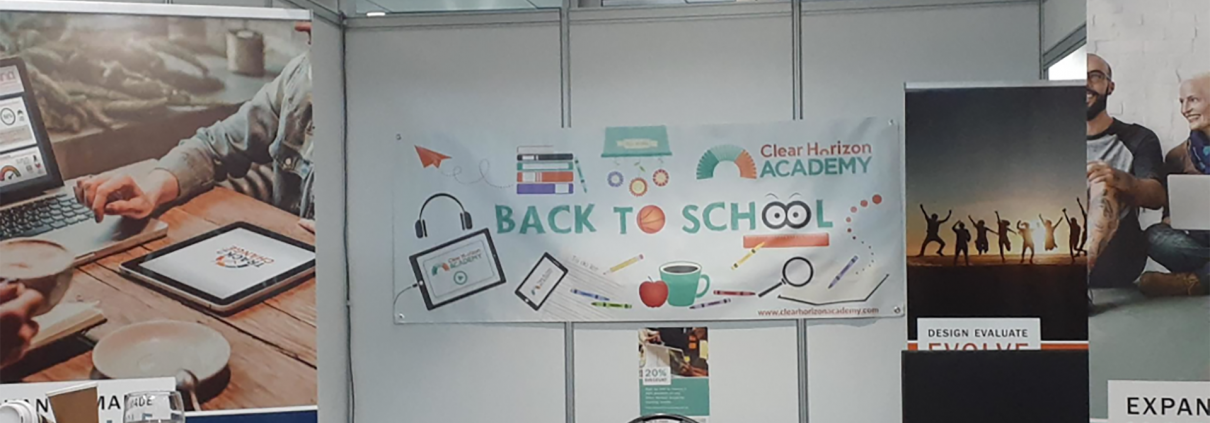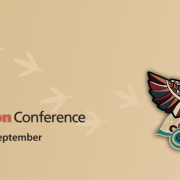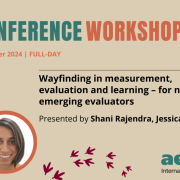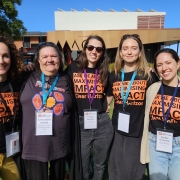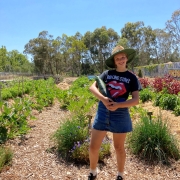AES International Evaluation conference Day 2!
It’s been an amazing AES conference so far – lots of interesting topics and great conversations. Like Jess, the highlight for me so far has been the key note speaker from day one, Dr Tracey Westerman – an Aboriginal woman from the Pilbara in WA. She has been a trail blazer in Aboriginal mental health. The key take away message for me was that measurement matters – but even more importantly, the right measures matter. She described that in many cases of Aboriginal youth suicide, there was been no prior mental health assessment. But when assessment tools are used, they are western based and not culturally appropriate. This can lead to misdiagnosis. For over 20 years, Tracey has argued that it is not appropriate to ‘modify’ existing measures because of their inherent racism. The only way is to develop new tools from the ground up. Tracey has developed seven tools specifically for Aboriginal youth mental health with not a lot of funding – no easy feat. It was a truly inspiring presentation from an amazingly passionate and optimistic woman who really cares about her people.
A highlights from day 2 was a panel of designers and evaluators from Australia and New Zealand: Jess Dart, Kate McKegg, Adian Field, Jenny Riley and Jacqueline (Jax) Wechsler, who explored how we might move out of the traditional box of program evaluation, to make a bigger difference. They discussed the role of evaluators in supporting people to move beyond measuring to think though whether we are doing the right things and whether we are really making a difference across complex systems. Questions were covered such as where can evaluators add value in a co-design process, does evaluation get in the way and slow things down, do evaluators need new skills to help analyse and make sense of big data? Jenny reminded us that evaluators are learners and we are curious, and that we need to get on board with the digital revolution.
One really interesting concurrent session I attended was on the use of Rubrics by Julian King, Kate McKegg, Judy Oakden and Adrian Field. They presented the basics of rubric and then described how rubrics can be a tool for democratising evaluative reasoning, stakeholder engagement and communicating of results. They presented two very different examples– one in a developmental evaluation and the other was using rubrics to evaluate the value for money of an agricultural funding program. I found the second example particularly interesting having experienced the challenges of answering the value for money question. Using a rubric in this way is great for balancing the multiple dimensions of value from different perspectives.
Another memorable moment was at an ignite session (which is a really short presentation). Damien Sweeny and Dave Green from Clear Horizon did a great job at presenting a rather convincing argument for placing more emphasis on monitoring over evaluation – Big M vs small e as they call it. And they cheekily suggested changing the name of the AES to AMeS. An interesting thought.
The day finished with a second keynote speaker, Gary VanLandingham, from the Askey School of Public Administration and Policy. He reminded us of the vast amount of evaluative information available through ‘What Works’ warehouses. They are a good place to start when starting an evaluation, but there are warnings. The main caution for me is that they privilege certain types of data over others, and they don’t include what doesn’t work or things not measured using experimental approach (such as randomised control trials, and quasi-experimental methods).
The day was topped off by a short ferry ride to Luna Park where we had a lovely conference dinner overlooking the opera house. Sydney is a very beautiful city and a great setting for a wonderful conference.
Now for day three….
Have you visited our booth at the conference?

